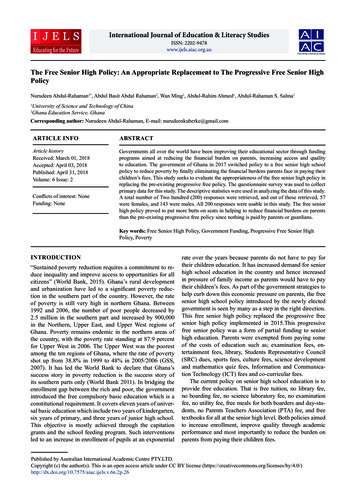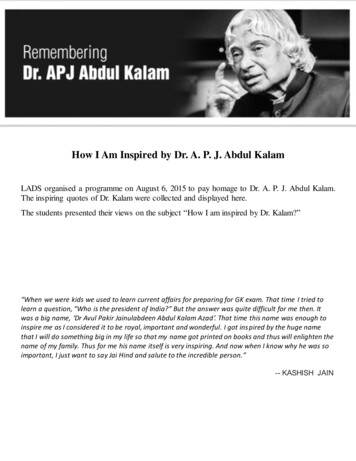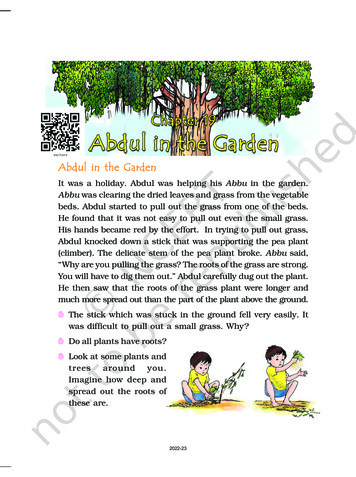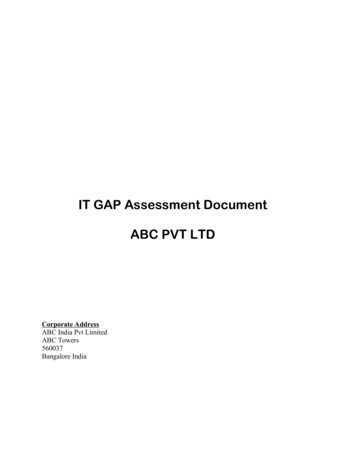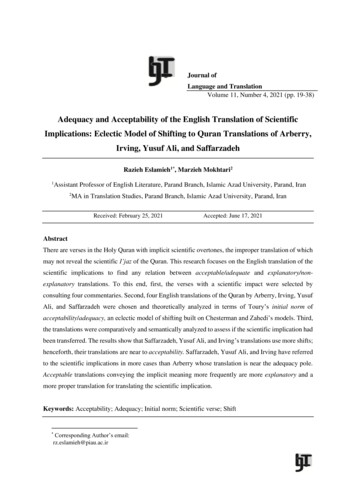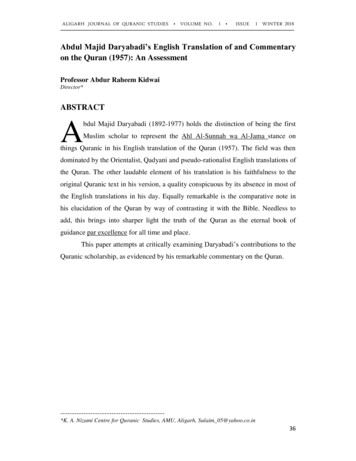
Transcription
ALIGARH JOURNAL OF QURANIC STUDIES VOLUME NO.1 ISSUE1 WINTER 2018Abdul Majid Daryabadi’s English Translation of and Commentaryon the Quran (1957): An AssessmentProfessor Abdur Raheem KidwaiDirector*ABSTRACTAbdul Majid Daryabadi (1892-1977) holds the distinction of being the firstMuslim scholar to represent the Ahl Al-Sunnah wa Al-Jama stance onthings Quranic in his English translation of the Quran (1957). The field was thendominated by the Orientalist, Qadyani and pseudo-rationalist English translations ofthe Quran. The other laudable element of his translation is his faithfulness to theoriginal Quranic text in his version, a quality conspicuous by its absence in most ofthe English translations in his day. Equally remarkable is the comparative note inhis elucidation of the Quran by way of contrasting it with the Bible. Needless toadd, this brings into sharper light the truth of the Quran as the eternal book ofguidance par excellence for all time and place.This paper attempts at critically examining Daryabadi’s contributions to theQuranic scholarship, as evidenced by his remarkable commentary on the *K. A. Nizami Centre for Quranic Studies, AMU, Aligarh, Sulaim 05@yahoo.co.in36
ALIGARH JOURNAL OF QURANIC STUDIES VOLUME NO.1 ISSUE1 WINTER 2018Amid Abdul Majid Daryabadi’s (1892-1977) many works, standing out asvaluable contributions to philosophy, Urdu literature and journalism and Islamicstudies, his magnum opus is his English translation of the Quran, The Holy Quran:Translated from the original Arabic, with lexical, grammatical, historical,geographical and eschatological comments, and explanations and sidelights oncomparative religion (1957). Its unusually long subtitle is fairly indicative of thewide range of material, especially comparative religion, covered in this feat ofscholarship. On the genesis of this pious venture Daryabadi’s own account is worthnoting:In 1933 while I had been staying for weeks at Mawlana Ashraf AliThanwi’s khanqah (spiritual training centre) I came into contactwith the Mawlana’s disciple, Maulwi Sirajul Haq Machhlishahri,who was a teacher at Majidia Intermediate College, Allahabad. Ouracquaintance soon grew into friendship. It was he who firstsuggested to me to embark upon the English translation of theQuran, arguing that no English version, representative of themainstream Muslim viewpoint (ahl al–Sunnah wa al–Jama) wasavailable. As I was fully aware of my inadequacies, especially of mycommand over English and Arabic, his suggestion took me bysurprise. However, he kept insisting on the pressing need for thiswork. His sincere persuasion prevailed and I embarked upon thisproject, notwithstanding my inability.As I commenced the job, its enormity gradually dawned upon me Itemporarily closed down my Urdu weekly Sach (from 1933 until1935), and cut down my other engagements. However, I realized thatit was essential to go through a plethora of tomes on lexicon,geography, history, world religions, culture and civilizations, tafsir,Hadith, scholasticism and jurisprudence etc for writing thecommentary on the Quran.37
ALIGARH JOURNAL OF QURANIC STUDIES VOLUME NO.1 ISSUE1 WINTER 2018The job of translation proved to be very tough, though the earliertranslations by Pickthall, Sale, Bell and Syed Hussain Bilgrami’sunpublished ones were helpful. The first draft was completed in lessthan two years. Then its typing took very long. Its pre-publicationcopy was sent to many for review and suggestions. However, therewas hardly any response. Throughout, I missed these two stalwartswho had by then passed away: i) Mawlana Hamiduddin Farahi whowould have resolved my queries about the Arabic usage and idiom,andii) Mawlana Muhammad Ali Jawhar who would haveimproved much my English presentation.In 1939, Taj Company, Lahore signed the contract, promising thatits thirty parts will be published in the next 30 months. In 1941 thefirst part came out, though it was highly defective. The second partappeared after a gap of two years in 1943. Despite numerousreminders and all possible efforts it was published in full only in1957, some 18 years after signing its contract.(1)It is indeed a pity that the publication of such a valuable work was so muchdelayed by the publisher’s apathy. Its three reprints were issued in 1962, 1970 and1971. During all these years Daryabadi kept on revising his tafsir, especially interms of updating it with the latest archaeological studies having some bearing onthe historical sites referred to in the Quran. After Daryabadi’s demise in 1977,Mawlana Abul Hasan Ali Nadwi took the initiative of acquiring the publishingrights of Daryabadi’s both English and Urdu tafasir under the aegis of the NadwatulUlema’s publishing house, the Academy of Islamic Research and Publications,Lucknow. Accordingly the revised edition of Daryabadi’s English tafsir in fourvolumes came out between 1981- 1985.Another significant development in the publication of Daryabadi’s Englishtafsir was also at the behest of Mawlana Nadwi. At the request of the leadingpublisher of books on Islam in the West, the Islamic Foundation, Leicester, UK,Mawlana Nadwi granted it permission to bring out a single volume edition of this38
ALIGARH JOURNAL OF QURANIC STUDIES VOLUME NO.1 ISSUE1 WINTER 2018work. This abridged edition contains the full English translation by Daryabadi andan intelligent, careful selection of his explanatory notes. This edition has beenre-issued several times by the Islamic Foundation. It is gratifying that itsdistribution at a large scale, especially among new Muslims in the West has beensponsored by some Arab philanthropists. Moreover, this edition has been reprintedby the Sidq Foundation, Lucknow, thanks to the laudable initiative and efforts ofHafiz Naimur Rahman Siddiqi. As a result, readers in the subcontinent now haveeasy access to this single volume abridged edition.Daryabadi’s work indeed filled a big gap in the then Quranic scholarship inEnglish. For there was hardly any reliable, satisfactory English translation by aMuslim scholar in 1930s when he undertook it. The only translations were byAbul Fadl (1911), Hairat Dihlawi (1916), Ghulam Sarwar (1920), MuhammadMarmaduke Pickthall (1930) and Abdullah Yusuf Ali (1934-1937). The ones byAbul Fadl and Hairat Dihlawi are eminently forgettable. For they were not thescholars of Islam. They were fired by their pious zeal to vindicate the truth ofIslam/the Quran against the aggressive and menacing Christian missionaryonslaught in the early twentieth century British India. Their presentation, however,leaves much to be desired. As to Ghulam Sarwar, he was a judge in Singapore. Aremarkable feature of his work is his extensive, scathing critique on the Orientalists’forays, namely the English translations of George Sale (1734) J. M. Rodwell (1861)and E. H Palmer (1880). His critique is a testament to his sound, sterlingscholarship, his discerning familiarity with the Orientalist discourse, his painstakingattention to detail and his sharp critical eye. However, all these qualities are notinexplicably reflected in his own translation of the Quran. Since he had his career inMalaya (present day Malaysia) as a civil servant, his translation did not receiveattention in the subcontinent. Another reason could be his ambivalent position onQadyanism. Although the Qadyani translator Muhammad Ali’s work (1917) figuresin his critique, he is all praise for the latter. Amid his glowing tribute he makes nomention of Muhammad Ali’s Qadyani credentials. Nor does he say a word aboutthe interpolation of Qadyani beliefs into Ali’s explanatory notes on the Quranwhich misguide the unsuspecting readers. Muhammad Marmaduke Pickthall’s is a39
ALIGARH JOURNAL OF QURANIC STUDIES VOLUME NO.1 ISSUE1 WINTER 2018translation only, with almost no explanatory note about the Quranic allusions or anybackground to the Quranic Surahs. For those new to Islam this translation is nothelpful. Abdullah Yusuf Ali’s, no doubt, contains copious notes, illustrating hiswide range of scholarship. However, his is a pseudo- rational, apologetic account ofthe Quranic description of al-ghayb (all that which lies beyond the domain of man’ssense perception). His branding of miracles and of the joys and punishments of theHereafter as symbolic or allegorical is discordant with the basic articles of Islamicfaith.(2) Little wonder then that the Ministry of Religious Affairs, Saudi Arabiawhich used to distribute thousands of free copies of Abdullah Yusuf Ali’s workdiscontinued this practice and got his work thoroughly revised by an expertcommittee. Since 1989 this revised and considerably abrogated edition has been incirculation.(3) The two other English translations, bearing Muslim names astranslators – Muhammad Abdul Hakim Khan (1905)(4) and Muhammad Ali (1917)were by Qadyanis and hence patently unreliable.Maulwi Sirajul Haq was not off the mark in his significant observationabout the non-existence of a credible English translation by a Muslim scholar.Armed with his mastery over English, his thorough familiarity with the Westernthought patterns, his first hand knowledge of comparative religion, and his Islamicfervour after his return to Islam and his knowledge of the finer details of themeaning and message of Islam which he had gained at the feet of Mawlana Thanwi,Daryabadi was suited best for taking up this formidable task. As he set out, hereceived much encouragement from Mawlana Thanwi, Mawlana Hussain AhmadMadni, Mawlana Manazir Ahsan Gilani, Syed Suleman Nadwi, Saiyyid Abul AlaMawdudi and others. Let us first recount Mawlana Thanwi’s advice to him, asreported by Daryabadi as part of his correspondence with the Mawlana:Daryabadi: I seek your blessings and advice about a highly importantmatter. For the last some weeks I have been thinking seriously of translatingthe Quran into English.Thanwi: I have felt its need for years. However, it calls for these tworequisites: i) competent translators, and ii) ample funds for its production.40
ALIGARH JOURNAL OF QURANIC STUDIES VOLUME NO.1 ISSUE1 WINTER 2018For these constraints it has remained so far my wish only. May be it is timefor the actualization of this dream.Daryabadi: Mawlana Hussain Ahmad Madni too, had asked me toundertake this work. However, I told him about my incompetence for thisundertaking. Although I am still aware of my inadequacies, I stronglyrealize the urgent need for this work. During this period I have supplicatedmany times after prayers that I be blessed with guidance and ability byAllah.Thanwi: You should embark upon it, taking Allah’s name. Allah mayprovide you with all that is required for it. The most important requirementis that a responsible person should undertake this job. Who is better suitedthan you for this? More importantly, this will give us the peace of mind. Inyour case we will have the satisfaction that you would keep consulting us. Inother words, it would be our collaborative effort.Daryabadi: Your encouragement about undertaking the English translationhas indeed inspired me much. Inshallah I will commence it in Ramadan.Thanwi: This news is so delightful for me like celebrating Idd in Ramadanitself.(5)Another significant piece is by Sayyid Abul Ala Mawdudi. On learning aboutDaryabadi’s venture he wrote this editorial note:I have gone through the special number of Sach (Daryabadi’sweekly) in which Abdul Majid Daryabadi has spelled out the needfor an authentic English translation and tafsir of the Quran. He hasmentioned the efforts he has already undertaken for accomplishingthis task. We endorse the view that a standard, reliable Englishtranslation is the need of the hour for not only non-Muslim Englishreadership, but also for another very large constituency comprisingmodern educated Muslims. They need it for gaining the correct41
ALIGARH JOURNAL OF QURANIC STUDIES VOLUME NO.1 ISSUE1 WINTER 2018understanding of Islam. It is an accepted fact that among ourmodern educated group, the best person to take up this job isMawlana Abdul Majid Daryabadi. For he has already passedthrough the stages in which most of the Western educated personsfind themselves entangled. He is fully alive to the fact how skepticismand atheism make their inroads into the hearts and minds. ByAllah’s grace he is equipped well with the knowledge and resourcesto counter the challenges posed by skepticism and atheism. Since heis the most suitable person, it is likely that he would accomplish thisjob. (6)Let us now turn to some of the distinctive features of Daryabadi’s venture.First, he holds the distinction of being the pioneer in the Indian subcontinent to haveauthored his tafsir in English which is perfectly in accordance with the primaryIslamic sources. Moreover, far from being a loose, lax paraphrase of the originalQuran as in the case of Abdullah Yusuf Ali’s work, his is faithful to the original tothe extent possible. His tafsir abounds in material on comparative religion, gleanedfrom primary sources. Moreover, his elucidation of eschatology, polygamy, jihadand miracles etc. does not smack of apologia. Rather, his cogent tafsir, drawing atplaces on the Bible and modern Western thought, succeeds largely in establishingand highlighting the eternal message and truth of the Quran. It goes a long way inallaying the doubts agitating the minds of the Muslims exposed to Western thoughtpatterns. Gifted with a deep insight into the nuances of the Quranic idiom and athorough, first-hand knowledge of the latest anthropological, archaeological andsociological studies, he explicates the meaning and significance of some enigmaticQuranic expressions. The Quranic term Nasara (al-Baqarah 2: 62) is usuallytranslated carelessly as Christians, even by Muslim translators. Daryabadi, however,renders it as “Nazarenes” on the ground that the “Nazarenes or the primitiveChristians were the followers of the pre-Pauline Church, not quite like the presentday Christians of the Pauline variety.” (7) At another place Daryabadi vindicates theveracity of the Quranic description (al-Baqarah 2: 60) of the twelve springs gushingforth miraculously from a rock in Sinai, as Prophet Moses (peace and blessings beupon him) struck it with his rod: “This wonderful rock, real, not fictitious, exists42
ALIGARH JOURNAL OF QURANIC STUDIES VOLUME NO.1 ISSUE1 WINTER 2018even to this day. It stands in the wide valley of Leja, under the Rass of Sufsafeh.”(8)Significantly enough, while the Qadyani translator Muhammad Ali denies thisincident altogether, Abdullah Yusuf Ali plays it down as some local tradition whichshould be better interpreted as a parable.While elucidating the Quranic statement: “And Sulaiman did notblaspheme” (al-Baqarah 2: 102), Daryabadi contributes this insightful explanatorynote:The Jews, true to their traditions of ingratitude and malevolencehave not hesitated to malign their own hero and national benefactor,Prophet Solomon (peace and blessings be upon him) and to accusehim of the most heinous of all offences – idolatry (The Bible, TheFirst Book of Kings, ii, iv, ix and x) The Quran upholds the honourof all Prophets of God, to whatever race or age they may belong.(9)Among the Muslim English translators of the day it was thus Daryabadialone who explained the above enigma, as blasphemy is unthinkable in the contextof a Messenger of Allah. He adds that the Quranic assertion about ProphetSolomon’s unblemished conduct is corroborated by modern Biblical studies whichshow that “Solomon was a sincere worshipper of Yahwe.”(10) It is commonknowledge that the Quran addresses in particular the children of Israel, repeatedlymentions their history and confers upon them the coveted title of being Allah’sfavourites (al-Baqarah 2: 40 and 47). This special attention to them is explainedthus by Daryabadi:The children of Israel had been the nation of priests, patriarchs andprophets, blessed of their Lord and were in the early days ofIslam, in effect intellectually, the dominating masters of the country.In matters religious and divine they were the trusted advisors of theunlettered pagans and their acknowledged superiors. It helps toexplain the extent of attention they receive in the Quran and the longseries of admonitions, warnings and exhortations addressed tothem.(11)43
ALIGARH JOURNAL OF QURANIC STUDIES VOLUME NO.1 ISSUE1 WINTER 2018In al-Baqarah 2: 102 the Quran designates Harut and Marut as the twoangels sent down by Allah, who taught magic to men. Unnerved by this apparentlyanomalous Quranic statement, Abdullah Yusuf Ali resorts to pleading: “The word”angels “as applied to Harut and Marut is figurative. It means good men, ofknowledge, science (or wisdom), and power.” (12) Without any streak of apologia,Daryabadi explains away that these angels were sent downin order that its nature [i.e. of magic and witch craft] be explainedand its mischief be demonstrated in full, and people may be weanedfrom the engulfing superstitions, just as a physician acquires anintimate knowledge of diseases not of course to propagate but tocombat these (13)For pressing home Allah’s Omnipresence and the pre-requisites for piety theQuran says:The east and the west belong to Allah. To whichever direction youturn, you will turn to Allah. Surely Allah is All Embracing, AllKnowing.(al-Baqarah 2: 115)It is not virtue that you turn your faces to the east or west. Virtue isto believe in Allah (al-Baqarah 2:177)Insightfully Daryabadi points out that the above verses aim also atdenouncing the prevalent practice of “Direction Worship”, a popular form ofpolytheism:To the East the Christians, in common with the sun-worshippers andmany other polytheists attach special sanctity. From the very earlytimes and in more than one ethnic religion, the direction towardswhich the worshipper made his prayer was considered of greatimportance. The Essenes prayed in the direction of the rising sunand the Syrian Christians also turned eastward at prayer. To theChristians again the West is full of meaning: “In the rite of44
ALIGARH JOURNAL OF QURANIC STUDIES VOLUME NO.1 ISSUE1 WINTER 2018baptism the catechumen was placed with the face toward thewest.” (Taylor, Primitive Culture, p. 428) “In Greek religion, deitieswere classified as Olympians and Chthonians. The East was theabode of the Olympian gods while the West was the directionwhich the worshippers of the Chthonian gods faced” (Hastings,Dictionary of the Bible, Vol. 5, p. 143). According to Hindus, thedirection of south-east was to Manu “(Hastings, Encyclopaedia ofReligion and Ethics, Vol. 12, p. 618).It was the belief of the early Church that the evil entered from thenorth. The above quoted Quranic verse (al-Baqarah 2: 177) strikesat the root of the “Direction Worship” and says in effect that there isno merit at all in turning towards any particular direction. Islamicworship, it must be manifest to the reader, is not directed towardsany direction as such – east west, north or south, but towards Ka’ba,a particular House, on whatever side of the worshipper it mayhappen to be.(14)Daryabadi achieved another distinction of bringing into sharper light theexcellence of the Quran by comparing and contrasting several Quranic and Biblicalpassages. Apart from reinforcing the conviction of Muslim readers, this feature ofhis tafsir is of immense appeal to the new Muslims. A weighty testimony to thiscontention is afforded by the assertion of a leading new Muslim lady of our time,Maryam Jameelah. In her piece “How I Discovered the Quran,” she states: my immature mind regarded the Quran as nothing more thandistorted and garbled versions of the former stories from theBible. ularly the parts dealing with comparative religion and learnedmuch from it.(15)Apart from hundreds of quotations from the Authorized Version of theBible, as part of his comparative study, Daryabadi draws also upon these45
ALIGARH JOURNAL OF QURANIC STUDIES VOLUME NO.1 ISSUE1 WINTER 2018prestigious Western sources on comparative religion: Pallen and Wyne’s NewCatholic Dictionary; Josephus’s Antiquities of the Jews; Hastings’s Dictionary ofthe Bible; Smith’s and Cheetham’s Dictionary of Christian Antiquities; Hastings’sEncyclopedia of Religion and Ethics; Cohen’s Everyman’s Talmud; and Valentine’sJewish Encyclopaedia.Instances illustrative of Daryabadi’s comparative strain are as follows:1) In explaining the Quranic expressions al-sama (heavens) occurringin al-Baqarah 2: 22, Daryabadi is quick to “refute the Biblical notionof heaven as the dwelling place of God as mentioned in The Book ofPsalms 11: 4 and 33: 13 and 14. In a sharp contrast to this, Islamlooks upon the idea of God occupying a certain space aspreposterous.”(16)2) While elucidating al-Baqarah 2: 48, which states the concept ofAllah’s forgiveness, Daryabadi points out that it aims to “repudiatethe Rabbinical doctrine that ‘grace is to be given to some because ofthe merits of their ancestors, to others because of the merits of theirdescendants’ (The Jewish Encyclopedia, Vol. 6, p. 61).(17)3) That the Quranic concept of God, as outlined in al-Baqarah 2:160, isradically different from the Biblical one is brought into sharper focusby Daryabadi thus: “The God of Islam, unlike the God of so manyreligions, is neither jealous nor vindictive. This requires frequentreiteration not only in view of the doctrines of the pagans but also ofthe teachings of the Bible (See Joshua 24: 19).”(18)4) In spelling out the Quranic laws of war laid down in al-Baqarah2: 190, Daryabadi compares these with the laws of war in the Bibleby citing 2 Kings 3: 25, 1 Kings 11:16 and 1 Samuel 15: 3, whichbrings out the ethical superiority of the Quranic laws of war. (19)5) In elaborating the Quranic directive that a believer should seek goodin both this and the Next world, as mentioned in al-Baqarah 2: 201,Daryabadi contrasts it with the Biblical directive in John 18: 36 andinforms readers that the Bible is concerned only with the Next Life.46
ALIGARH JOURNAL OF QURANIC STUDIES VOLUME NO.1 ISSUE1 WINTER 2018Daryabadi’s exposition is indeed gratifying and reassuring for thoseengaged in lawful worldly activities. For, according to the Quran heis one who performs a religious duty and is assured of divine rewardin the Hereafter.(20)6) While discussing the Quranic observation about the menstruatingwomen in al-Baqarah 2: 222 Daryabadi demonstrates that theBiblical regulations in this respect, as recorded in Leviticus 15:19-21,are far more rigid.(21)7) Daryabadi’s note on al-Baqarah 2: 228 compares the Quranic andBiblical stances on divorce. It conclusively shows Islam as thenatural way, representing the middle path. He maintains:The course of divorce, or dissolution of the marriage tie,among ancient nations has been erratic, some making it tooloose, others making it too tight The Jewish law allows itas a matter of no great concern (See Deuteronomy 24: 1 and2). Christianity, on the other hand, taking its stand on thereported saying of Prophet Jesus (See Mark 10:9 and 11) andalso upon the dictum of Paul (See 1 Corinthinians 7: 10) hasinterdicted divorce altogether The climax was reached inthe rules of the Roman Catholic Church It treats marriageas a sacrament and demands indissolubility and unchangingfidelity. Islam has steered the course midway between thetwo, avoiding the extremes of either making divorce too rigidand banning it altogether, or of making it too loose andfrivolous.(22)8) Likewise, on comparing the status of women in the Quran(al-Baqarah 2: 228) and the Bible, Daryabadi points to the lead takenby Islam in according rights and honour to woman:According to the Quran, women have rights quite similar tothose of men. This bold and explicit declaration of the rightsof women centuries before a Mill dreamt of writing on the“Subjection of women” has no parallel in the pages of other47
ALIGARH JOURNAL OF QURANIC STUDIES VOLUME NO.1 ISSUE1 WINTER 2018Scriptures. Contrast this with the attitude of the Bible whichas a punishment of the sin of Eve makes wife a subject to herhusband who is to rule over her. According to the OldTestament, woman is responsible for the fall of man, and thisbecame the cornerstone of Christian teachings It is aremarkable fact that the Gospels (barring Matthew 19: 9)contain not a word in favour of woman The Epistles ofSt. Paul definitely insist that no change be permitted in theposition of woman St. Jerome has aught but good to say ofwoman:” Woman is the gate of devil, the road of evil, thesting of the scorpion.” Canon Law declares: “Man only iscreated in the image of God, not woman; therefore womanshall serve him and be his handmaid.” Kraft Ebing,Psychopathia Sexualis).(23)9) In explaining the Quranic injunction prohibiting usury (al-Baqarah2:275) Daryabadi, once again, points to the ethical superiority of theQuran:The devastating propensities of usury are visible to everyeye Yet it is Islam alone that has the unique distinction ofdeclaring this pernicious practice illegal absolutely andunconditionally. The Bible forbade the usurious loans tothe Israelites (see Exodus 22: 25 and Deuteronomy 23: 19).But even the Biblical prohibition did not include usuriousloans to non-Israelites. It is the Holy Quran, which to itseverlasting glory has forbidden usury in all its formscategorically.(24)Mawlana Abul Hasan Ali Nadwi, who besides his other distinctions, was aQuranic scholar par excellence. His following note on Daryabadi’s work drawsattention to some other merits of Daryabadi’s work:There was, however, the need for another English translation of theHoly Quran, complete with explanatory notes, which could be48
ALIGARH JOURNAL OF QURANIC STUDIES VOLUME NO.1 ISSUE1 WINTER 2018recommended with confidence to Muslims and non-Muslims Theauthor of such an exegesis inevitably had to expound the Quranictext in terms acceptable to scholars of Ahl al Sunnah wa al-Jama’ah;to avoid putting forward his own views and ideas into the exegesis;to be fully conversant with Arabic lexicon and rules of grammar andto avoid apologetic approach in expounding the Quranic injunctionsand institutions; to have faith in Life-After-Death and the rewardsand retributions promised in the Quran as divine pronouncementsinstead of taking them merely as symbolical expressions , toexpound the significance of the Quranic injunctions in regard topolygamy, slavery, dowry, the execution of apostates, blood moneyetc Taking all these factors into account, Abdul Majid Daryabadi’stranslation and commentary is undoubtedly unique and mostacceptable among all the exegetical renderings of the Holy Quran sofar attempted in the English language.The exegesis by Daryabadi throws ample light on all thosecommunities who have been mentioned in the Holy Quran alongwith their geographical locations and the eras in which theyflourished. His exegesis also demonstrates in the light of humanexperience and researches made in the field of anthropology andsociology, the superiority of Islamic social order and its legislationspertaining to marriage, divorce, inheritance etc. It shows howIslamic injunction represents the most refined and elaborate systemof social existence known to the civilized world.In addition to these, a distinguishing feature of Daryabadi’s exegesisis that it provides a conclusive answer to those Jewish and Christiancritics who claim that the Holy Quran draws its material from theScripture and apocryphal writings of Judaism and Christianity.49
ALIGARH JOURNAL OF QURANIC STUDIES VOLUME NO.1 ISSUE1 WINTER 2018Another distinctive feature of Daryabadi’s rendering of the Quranictext is that he has always kept in view the most appropriateexpressions in English or the one which is the nearest to theinterpretation of a word used in the Holy Quran.Abdul Majid Daryabadi has acquitted himself of this onerous task ina laudable manner. Throughout his life he preoccupied himself withthe study of the Holy Quran and wrote an exegesis in Urdu inaddition to the English one. His translation and commentary, is, tomy mind, unique and most reliable among all translations andcommentaries of the Quran so far attempted in the Englishlanguage.(25)That Daryabadi was alive to the present day challenges for a mufassir(the Quran exegete) comes out in his tafsir, as Mawlana Nadwi points out, and alsoin his following piece which he wrote in his last days. This illustrates his alertnessto the current issues and his keen desire that these be studied and resolved in thelight of the Quran. His profound observations offer much food for thought for theQuran scholars of our time. Furthermore, these give a clear idea of some of theconcerns which Daryabadi had in mind while writing his tafsir in both English andUrdu. These project him as a genuine seeker of the truth embodied in the Quran andthe perfect amalgam of tradition and modernity, and faith and reason in hisapproach to tafsir. More importantly, the issues raised by him should be taken up bythe present day Quran scholars. The sooner it is done, the better it would be for thecause of a better understanding of the meaning and message of the Quran:There has been information explosion in the twentieth century. Thechallenges posed by modern scholarship were therefore not faced byearlier Quran scholars. Some new questions, however, today stare inthe face of the students of the Quran. Many recent historical,geographical and archaeological findings need to be investigated inline with their Quranic version.50
ALIGARH JOURNAL OF QURANIC STUDIES VOLUME NO.1 ISSUE1 WINTER 2018History holds the pride of place as an academic discipline in that theQuran cites several historical communities and personalities Regarding Prophets John and Zakariyya (peace and blessings beupon them) the latest historical studies have unearthed a mine ofinformation. What is needed is that the new s
things Quranic in his English translation of the Quran (1957). The field was then dominated by the Orientalist, Qadyani and pseudo-rationalist English translations of the Quran. The other laudable element of his translation is his faithfulness to the original Quranic text in his version, a quality conspicuous by its absence in most of the .
